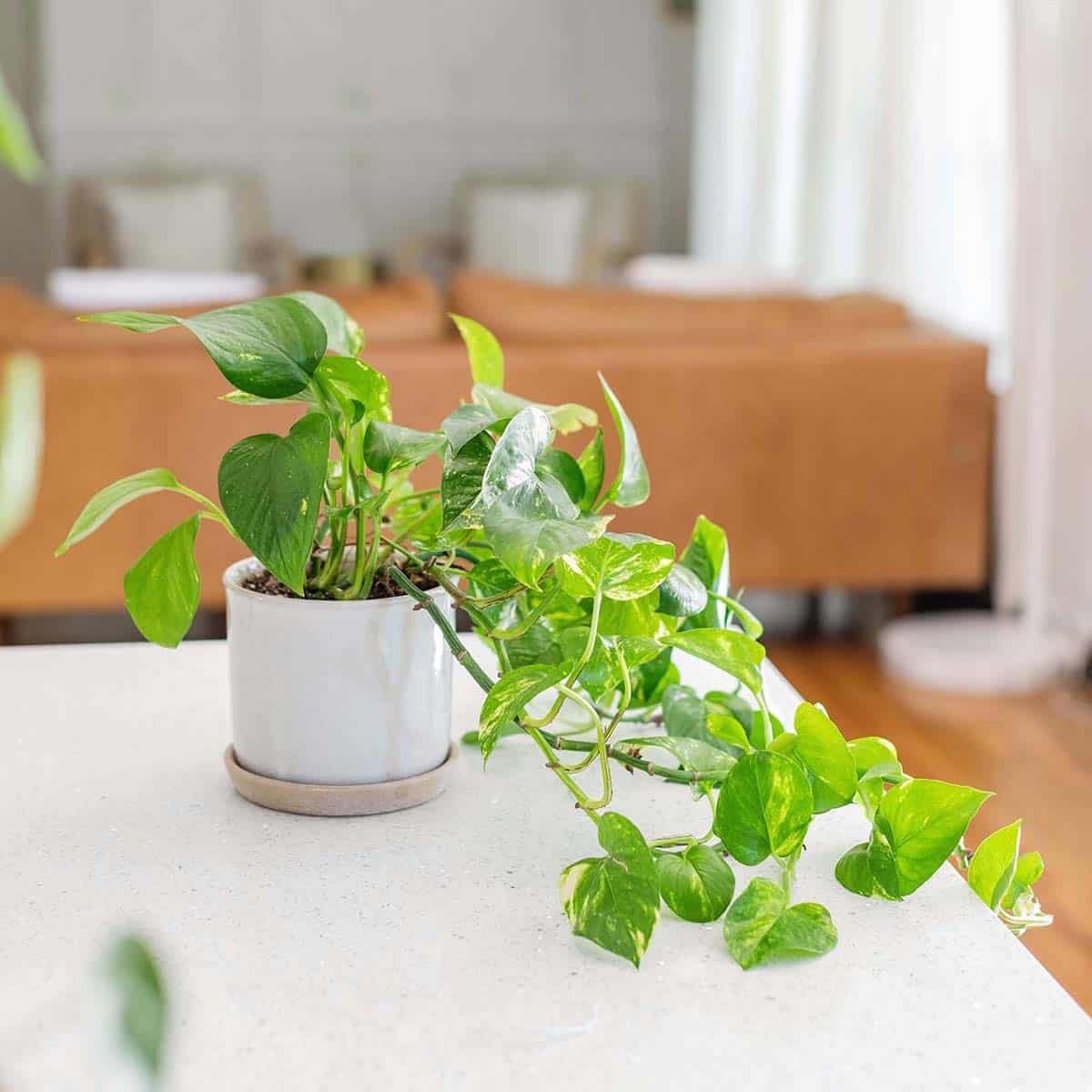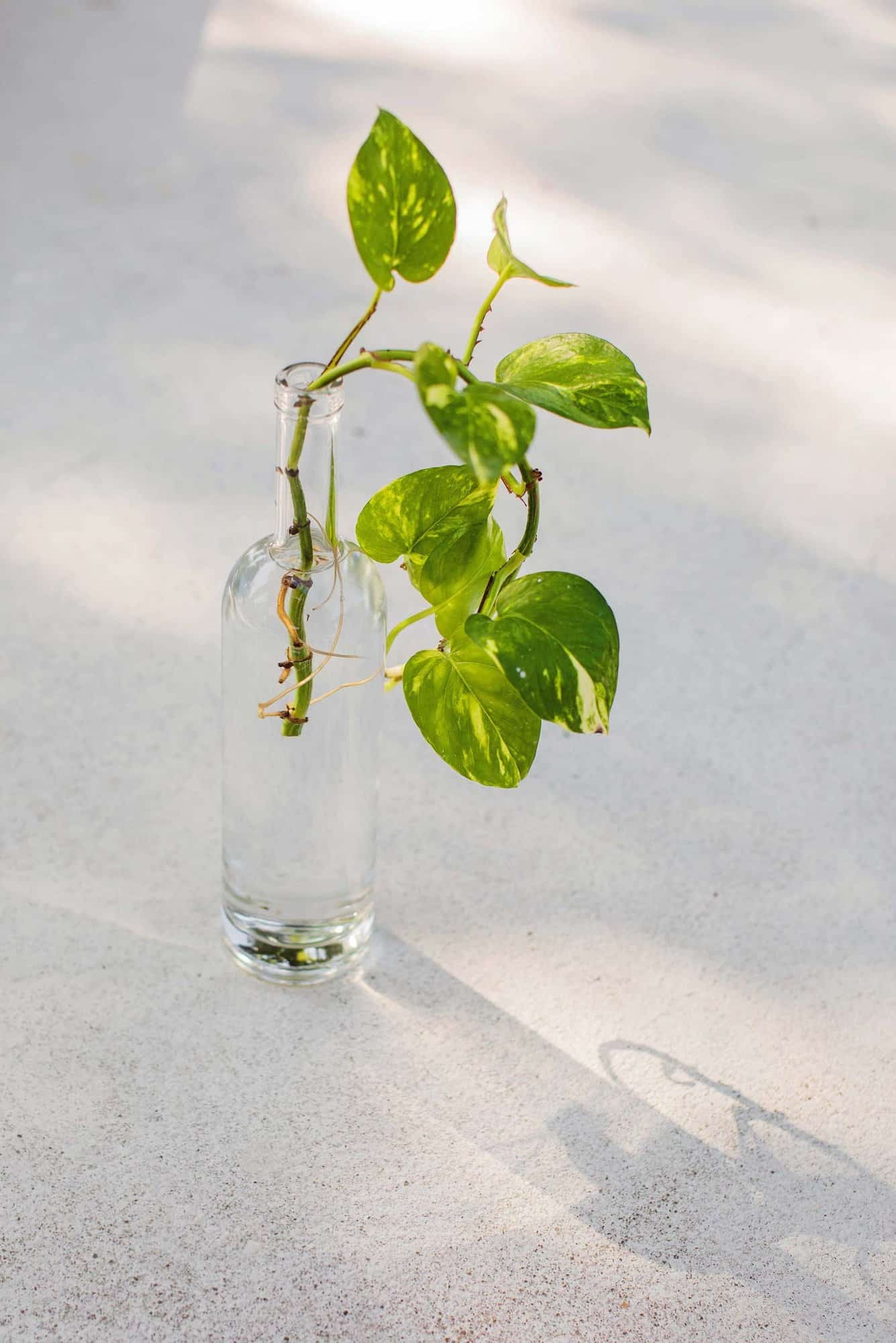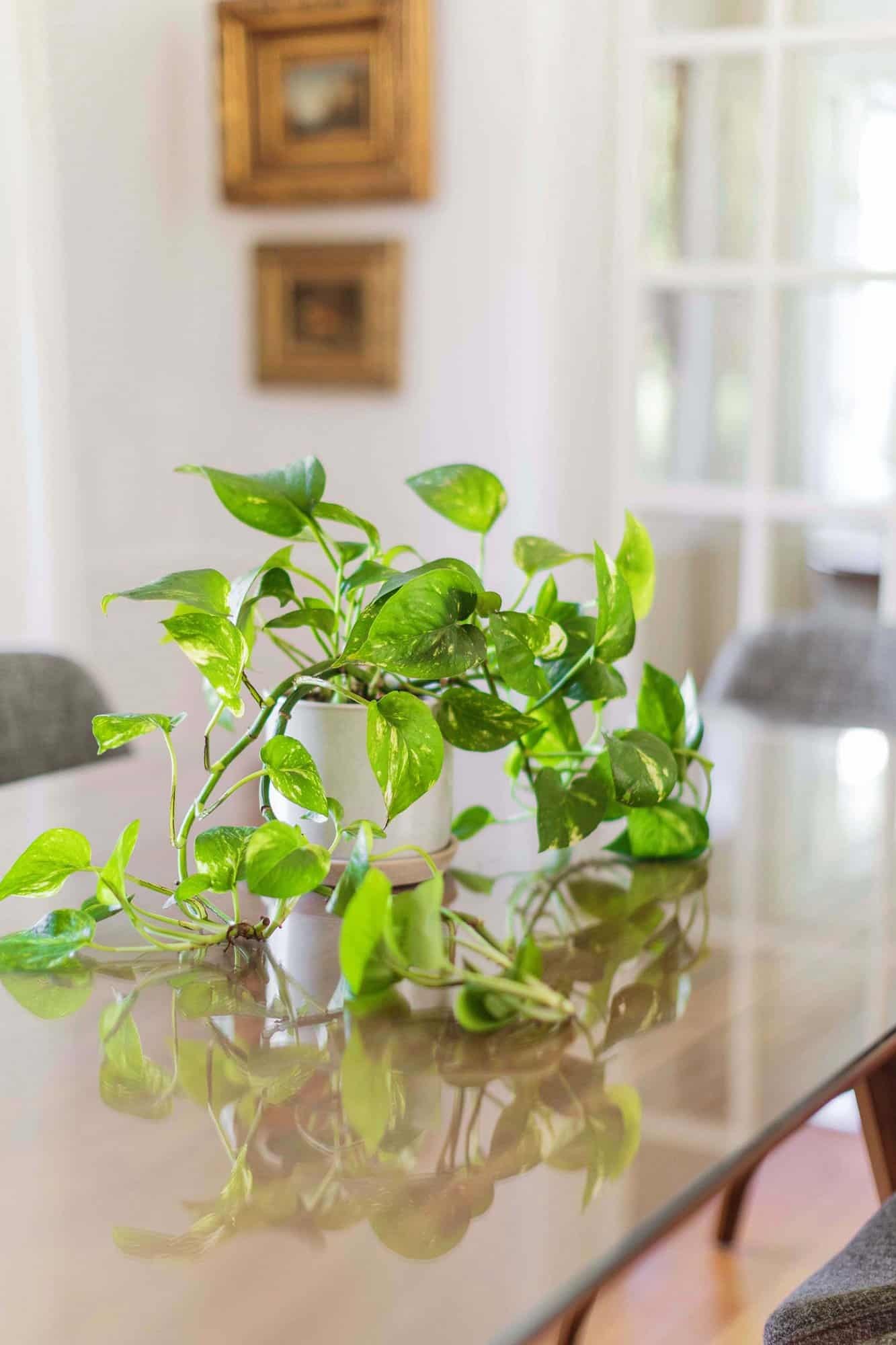Golden Pothos care is simpler than you might think, making it a favorite for both beginners and seasoned plant enthusiasts. At CARS.EDU.VN, we understand the importance of creating a thriving indoor environment, and the Golden Pothos is a perfect starting point, offering air purification benefits and lush greenery. This comprehensive guide will walk you through everything you need to know, from selecting the right pot to troubleshooting common issues, ensuring your pothos thrives for years to come. Discover more about indoor plant care and create a green oasis with CARS.EDU.VN’s expert advice on foliage plants and devil’s ivy cultivation.
1. Understanding the Golden Pothos
The Golden Pothos (Epipremnum aureum), also known as Devil’s Ivy, is a popular houseplant celebrated for its vibrant, heart-shaped leaves and trailing vines. Originating from the Araceae family, this plant is incredibly versatile and adaptable, making it a great choice for indoor spaces. According to a study by NASA, pothos plants are effective at purifying indoor air, removing toxins like formaldehyde, xylene, and benzene.
Its resilience and tolerance to various growing conditions make it an excellent option for beginners, while its aesthetic appeal makes it a favorite among experienced plant enthusiasts.
1.1 Identifying a Healthy Golden Pothos
When selecting a Golden Pothos, look for specific signs of health and vitality:
- Lush Foliage: The leaves should be vibrant green with distinct golden variegation. Avoid plants with pale or faded leaves.
- Upright Leaves: Healthy leaves stand upright and are not droopy. Drooping leaves can indicate underwatering or other issues.
- New Growth: Signs of new growth, such as small, emerging leaves, indicate that the plant is actively growing and thriving.
- Absence of Yellow or Brown Leaves: Yellow or brown leaves can signal overwatering, underwatering, or disease.
- Healthy Root System: If possible, check the roots for signs of rot. Healthy roots are firm and light-colored, while rotten roots are mushy and dark.
1.2 Benefits of Growing Golden Pothos
Growing Golden Pothos offers numerous benefits beyond its aesthetic appeal:
- Air Purification: As mentioned earlier, pothos plants are excellent air purifiers, removing common household toxins and improving indoor air quality. A study published in the Journal of Environmental Horticulture found that pothos plants significantly reduce indoor air pollutants.
- Low Maintenance: Golden Pothos is incredibly easy to care for, making it suitable for beginners. It tolerates a wide range of conditions and requires minimal attention.
- Versatile Decor: Its trailing vines make it an excellent choice for hanging baskets, shelves, and desktops. It can also be trained to climb trellises or moss poles.
- Easy Propagation: Golden Pothos is one of the easiest plants to propagate, allowing you to expand your collection or share cuttings with friends.
- Stress Reduction: Studies have shown that indoor plants can reduce stress levels and improve overall well-being.
2. Essential Supplies for Golden Pothos Care
To ensure your Golden Pothos thrives, gather these essential supplies:
- Potting Mix: A well-draining potting mix is crucial. Use a standard indoor potting mix or create your own blend.
- Pots: Choose pots with drainage holes to prevent root rot. Terra cotta pots are an excellent option due to their breathability.
- Watering Can: Use a watering can with a long spout to reach the soil without wetting the leaves.
- Pruning Shears: Keep pruning shears clean and sharp for trimming and propagating your pothos.
- Fertilizer: A balanced liquid fertilizer will provide essential nutrients during the growing season.
- Spray Bottle: Use a spray bottle to mist the leaves, increasing humidity.
- Support Structure: If you want your pothos to climb, provide a trellis, moss pole, or other support structure.
2.1 Selecting the Right Potting Mix
The right potting mix is vital for healthy growth. Golden Pothos prefers a well-draining mix that retains some moisture. You can use a standard indoor potting mix or create your own blend by combining:
- Potting Soil: Provides essential nutrients and structure.
- Perlite: Improves drainage and aeration.
- Orchid Bark: Adds aeration and prevents soil compaction.
According to the University of Minnesota Extension, a well-draining potting mix prevents waterlogging and root rot, common issues with indoor plants.
2.2 Choosing the Perfect Pot
Selecting the right pot is essential for your Golden Pothos. Consider these factors:
- Material: Terra cotta pots are breathable, allowing excess moisture to evaporate. Plastic pots retain more moisture and are suitable if you tend to underwater.
- Size: Choose a pot that is one size larger than the current pot. Repotting to a larger pot provides room for the roots to grow.
- Drainage: Ensure the pot has drainage holes to prevent water from accumulating at the bottom. If you use a decorative pot without drainage holes, place a smaller pot inside and remove it for watering.
2.3 Recommended Tools for Pothos Care
Having the right tools makes caring for your Golden Pothos easier and more efficient:
| Tool | Purpose | Recommendation |
|---|---|---|
| Watering Can | Delivers water directly to the soil without wetting the foliage. | Choose a watering can with a long, narrow spout for precise watering. |
| Pruning Shears | Trims and prunes vines, removes dead or yellow leaves, and prepares cuttings for propagation. | Opt for sharp, clean pruning shears to prevent disease transmission. |
| Spray Bottle | Mists leaves to increase humidity, especially in dry environments. | Use a fine-mist spray bottle to evenly distribute moisture. |
| Liquid Fertilizer | Provides essential nutrients for healthy growth during the growing season. | Choose a balanced liquid fertilizer with an NPK ratio of 10-10-10 or similar. |
| Moisture Meter | Measures the moisture level in the soil, helping you determine when to water. | Use a moisture meter to avoid overwatering or underwatering. |





3. Planting Your Golden Pothos
Planting your Golden Pothos involves selecting the right pot, preparing the potting mix, and carefully transferring the plant. Here’s a step-by-step guide:
3.1 Step-by-Step Planting Guide
- Select a Pot: Choose a pot that is one size larger than the current pot with drainage holes.
- Prepare the Potting Mix: Use a well-draining potting mix or create your own blend.
- Remove the Plant: Gently remove the Golden Pothos from its current pot, being careful not to damage the roots.
- Inspect the Roots: Check the roots for signs of rot and trim any dead or mushy roots.
- Place the Plant: Place the plant in the new pot, ensuring the top of the root ball is level with the top of the pot.
- Add Potting Mix: Fill the pot with potting mix, gently pressing down to remove air pockets.
- Water Thoroughly: Water the plant thoroughly until water drains from the bottom of the pot.
3.2 Best Time to Plant
The best time to plant or repot your Golden Pothos is during the spring or early summer. This is when the plant is actively growing, and it will recover quickly from the transplant. Avoid planting during the winter when the plant is dormant.
3.3 Potting and Repotting Considerations
When potting or repotting your Golden Pothos, keep these considerations in mind:
- Pot Size: Always choose a pot that is one size larger than the current pot to provide room for the roots to grow.
- Root Bound: If the roots are tightly circling the bottom of the pot, gently loosen them before repotting.
- Soil Compaction: Avoid compacting the soil too much when potting. The soil should be loose and well-aerated.
4. Lighting Requirements for Golden Pothos
Golden Pothos is adaptable to various lighting conditions, but it thrives in bright, indirect light. Understanding its lighting needs is crucial for healthy growth.
4.1 Ideal Lighting Conditions
The ideal lighting conditions for Golden Pothos include:
- Bright, Indirect Light: This provides sufficient light for growth without scorching the leaves.
- Filtered Sunlight: If placing near a window, use sheer curtains to filter direct sunlight.
- Avoid Direct Sunlight: Direct sunlight can burn the leaves and cause them to turn yellow or brown.
According to Clemson Cooperative Extension, providing adequate light is essential for the plant’s variegation and overall health.
4.2 Signs of Insufficient Light
If your Golden Pothos is not getting enough light, you may notice these signs:
- Loss of Variegation: The golden patterns on the leaves may fade or disappear.
- Slow Growth: The plant may grow very slowly or stop growing altogether.
- Small Leaves: New leaves may be smaller than usual.
- Leggy Growth: The vines may become long and sparse with fewer leaves.
4.3 Utilizing Artificial Light
If you don’t have enough natural light, you can use artificial light to supplement the plant’s needs. Fluorescent or LED grow lights are excellent options. Place the light source 6-12 inches above the plant and provide 12-14 hours of light per day.
5. Watering Your Golden Pothos
Proper watering is essential for the health of your Golden Pothos. Overwatering and underwatering are common issues that can be easily avoided with a consistent watering schedule.
5.1 Creating a Watering Schedule
A consistent watering schedule is vital for Golden Pothos. Water the plant when the top 1-2 inches of soil are dry to the touch. This typically translates to watering every 1-2 weeks, but it can vary depending on the environment.
5.2 Best Watering Practices
Follow these best practices when watering your Golden Pothos:
- Check Soil Moisture: Before watering, check the soil moisture with your finger or a moisture meter.
- Water Thoroughly: Water the plant thoroughly until water drains from the bottom of the pot.
- Discard Excess Water: Discard any excess water that collects in the saucer to prevent root rot.
- Use Lukewarm Water: Use lukewarm water (around 60 degrees Fahrenheit) to avoid shocking the roots.
- Watering Frequency: Reduce watering frequency during the winter months when the plant is dormant.
5.3 Identifying Overwatering and Underwatering
Recognizing the signs of overwatering and underwatering can help you adjust your watering schedule and prevent issues:
- Overwatering: Yellowing leaves, droopy leaves, mushy stems, and root rot.
- Underwatering: Brown, crispy leaves, droopy leaves, and dry soil.
6. Pruning and Training Your Golden Pothos
Pruning and training your Golden Pothos can enhance its appearance and promote healthy growth. Regular pruning encourages bushier growth, while training allows you to shape the plant to your liking.
6.1 Pruning Techniques
Use clean, sharp pruning shears to trim your Golden Pothos. Prune the vines just above a leaf node to encourage new growth. You can also remove any dead or yellow leaves to keep the plant healthy.
6.2 Best Time to Prune
The best time to prune your Golden Pothos is during the spring or summer when the plant is actively growing. Avoid pruning during the winter when the plant is dormant.
6.3 Training Your Pothos
You can train your Golden Pothos to climb a trellis, moss pole, or other support structure. Gently guide the vines around the support and secure them with plant ties or clips. This can create a beautiful vertical display.
7. Propagating Your Golden Pothos
Propagating Golden Pothos is a simple way to expand your collection or share cuttings with friends. The most common methods are water propagation and soil propagation.
7.1 Water Propagation Method
- Take a Cutting: Cut a healthy vine with several leaves and nodes.
- Remove Lower Leaves: Remove the leaves from the bottom 2-3 inches of the cutting.
- Place in Water: Place the cutting in a glass or jar filled with water, ensuring the nodes are submerged.
- Change Water Regularly: Change the water every 1-2 days to prevent bacterial growth.
- Wait for Roots: Roots will typically develop in 1-2 weeks.
- Plant in Soil: Once the roots are 1-2 inches long, plant the cutting in a pot with well-draining potting mix.
7.2 Soil Propagation Method
- Take a Cutting: Cut a healthy vine with several leaves and nodes.
- Remove Lower Leaves: Remove the leaves from the bottom 2-3 inches of the cutting.
- Plant in Soil: Plant the cutting directly in a pot with well-draining potting mix.
- Keep Soil Moist: Keep the soil consistently moist until roots develop.
- Check for Roots: After a few weeks, gently tug on the cutting to check for root growth.
7.3 Tips for Successful Propagation
- Use Healthy Cuttings: Choose healthy, disease-free cuttings for the best results.
- Provide Warmth: Keep the cuttings in a warm location to promote root growth.
- Maintain Humidity: Increase humidity by misting the cuttings regularly or placing them in a humidity dome.
8. Fertilizing Your Golden Pothos
Fertilizing your Golden Pothos provides essential nutrients for healthy growth. Use a balanced liquid fertilizer during the growing season to support lush foliage and vibrant variegation.
8.1 Best Fertilizers to Use
Use a balanced liquid fertilizer with an NPK ratio of 10-10-10 or similar. Look for fertilizers specifically formulated for houseplants.
8.2 Fertilizing Schedule
Fertilize your Golden Pothos every 4-6 weeks during the spring and summer months. Reduce or eliminate fertilizing during the winter when the plant is dormant.
8.3 Signs of Over-Fertilization
Over-fertilization can harm your Golden Pothos. Watch for these signs:
- Brown Leaf Tips: Brown or crispy leaf tips can indicate a buildup of salts from the fertilizer.
- White Crust on Soil: A white crust on the soil surface is another sign of salt buildup.
- Slow Growth: Over-fertilization can inhibit growth.
9. Troubleshooting Common Issues
Even with the best care, you may encounter common issues with your Golden Pothos. Here are some troubleshooting tips to help you address these problems.
9.1 Yellowing Leaves
Yellowing leaves can indicate several issues:
- Overwatering: Reduce watering frequency and ensure the soil is well-draining.
- Underwatering: Increase watering frequency and check soil moisture regularly.
- Nutrient Deficiency: Fertilize the plant with a balanced liquid fertilizer.
- Pest Infestation: Inspect the plant for pests and treat accordingly.
9.2 Brown Leaves
Brown leaves can indicate:
- Underwatering: Increase watering frequency and check soil moisture regularly.
- Low Humidity: Increase humidity by misting the leaves or using a humidifier.
- Sunburn: Move the plant to a location with indirect light.
9.3 Drooping Leaves
Drooping leaves can indicate:
- Underwatering: Water the plant thoroughly and check soil moisture regularly.
- Overwatering: Reduce watering frequency and ensure the soil is well-draining.
- Temperature Stress: Avoid placing the plant near drafts or extreme temperatures.
9.4 Pest Infestations
Golden Pothos can be susceptible to common houseplant pests such as:
- Spider Mites: Treat with insecticidal soap or neem oil.
- Mealybugs: Remove with a cotton swab dipped in rubbing alcohol or treat with insecticidal soap.
- Scale: Remove manually or treat with horticultural oil.
10. Choosing the Right Environment
Creating the right environment for your Golden Pothos is essential for its health and vitality. Consider these factors to ensure your plant thrives.
10.1 Temperature and Humidity
Golden Pothos prefers temperatures between 65-85°F (18-29°C) and moderate to high humidity. Avoid placing the plant near drafts or extreme temperatures. Increase humidity by misting the leaves regularly or using a humidifier.
10.2 Air Circulation
Good air circulation is essential to prevent fungal diseases. Ensure the plant is not overcrowded and has adequate space for air to circulate around the leaves.
10.3 Placement Tips
- Avoid Direct Sunlight: Place the plant in a location with bright, indirect light.
- Consider Humidity: Bathrooms are excellent locations due to the high humidity.
- Keep Away from Drafts: Avoid placing the plant near drafts or heating vents.
11. Varieties of Golden Pothos
While the classic Golden Pothos is widely recognized, there are several other varieties, each with unique characteristics.
11.1 Popular Pothos Varieties
- Marble Queen: Features striking white variegation on green leaves.
- Snow Queen: Similar to Marble Queen but with more white variegation.
- Neon Pothos: Displays bright, chartreuse green leaves.
- Jade Pothos: Features solid green leaves without variegation.
- Satin Pothos: Known for its silvery markings on dark green leaves.
11.2 Unique Characteristics of Each Variety
Each variety has unique characteristics in terms of leaf color, variegation patterns, and growth habits. Experiment with different varieties to add visual interest to your indoor plant collection.
11.3 Caring for Different Varieties
The care requirements for different pothos varieties are generally similar. However, some varieties may require slightly different lighting or watering schedules. Research the specific needs of each variety to ensure optimal growth.
12. Advanced Care Tips
For experienced plant enthusiasts, here are some advanced care tips to help your Golden Pothos thrive:
12.1 Using Grow Lights Effectively
Utilize grow lights to supplement natural light, especially during the winter months. Choose full-spectrum LED grow lights for optimal results.
12.2 Creating a Custom Potting Mix
Create a custom potting mix tailored to your plant’s needs. Experiment with different ratios of potting soil, perlite, and orchid bark to improve drainage and aeration.
12.3 Managing Pests and Diseases
Implement a proactive pest management strategy. Regularly inspect the plant for pests and diseases and take action at the first sign of infestation.
13. Frequently Asked Questions (FAQs)
1. How often should I water my Golden Pothos?
Water when the top 1-2 inches of soil are dry, typically every 1-2 weeks.
2. What kind of light does a Golden Pothos need?
Bright, indirect light is ideal. Avoid direct sunlight.
3. How do I propagate a Golden Pothos?
You can propagate it via water or soil propagation using stem cuttings.
4. Why are the leaves on my Golden Pothos turning yellow?
Yellowing leaves can indicate overwatering, underwatering, or nutrient deficiency.
5. Is Golden Pothos toxic to pets?
Yes, Golden Pothos is toxic to pets if ingested. Keep it out of reach of animals and children.
6. How do I make my Golden Pothos bushier?
Prune the vines regularly to encourage bushier growth.
7. What is the best fertilizer for Golden Pothos?
Use a balanced liquid fertilizer with an NPK ratio of 10-10-10 or similar.
8. How do I increase humidity for my Golden Pothos?
Mist the leaves regularly, use a humidifier, or place the plant in a bathroom.
9. Why are the leaves on my Golden Pothos turning brown?
Brown leaves can indicate underwatering, low humidity, or sunburn.
10. How often should I repot my Golden Pothos?
Repot every 1-2 years or when the plant becomes root-bound.
14. Conclusion: Nurturing Your Golden Pothos with CARS.EDU.VN
Caring for a Golden Pothos is a rewarding experience that brings beauty and clean air into your home. By following these comprehensive guidelines, you can ensure your pothos thrives for years to come. At CARS.EDU.VN, we’re dedicated to providing you with expert advice and resources to create a thriving indoor environment. Remember to provide adequate light, consistent watering, and occasional fertilization to keep your Golden Pothos healthy and vibrant.
14.1 Continued Learning Resources
For more in-depth information and resources on plant care, visit CARS.EDU.VN. Explore our extensive collection of articles, guides, and tips to enhance your gardening skills and create a lush, green oasis.
14.2 Call to Action
Ready to take your plant care journey to the next level? Explore our website at CARS.EDU.VN for expert advice, detailed guides, and a wealth of information to help you create a thriving indoor garden. Find the best tips for choosing the right plants, maintaining optimal growing conditions, and troubleshooting common issues.
14.3 Contact Information
For any inquiries or further assistance, feel free to contact us:
- Address: 456 Auto Drive, Anytown, CA 90210, United States
- WhatsApp: +1 555-123-4567
- Website: CARS.EDU.VN
Let cars.edu.vn be your trusted partner in creating a beautiful and healthy indoor environment.
